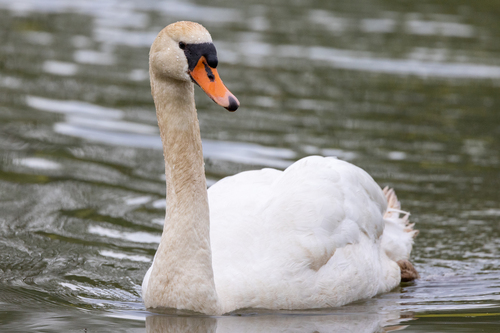
Mute Swan
The Mute Swan (Cygnus olor) is a large species of swan known for its elegant appearance and relatively quiet nature compared to other swan species. Native to Eurasia, it has been introduced to North America and other parts of the world, where it is sometimes considered an invasive species. Mute Swans play a significant role in their ecosystems as primary consumers of aquatic vegetation, influencing plant distribution and water quality. Culturally, they are often associated with grace, beauty, and love, appearing frequently in folklore and literature.
140-160 cm
Length
200-240 cm
Wingspan
Least Concern
Conservation Status
Distribution
Native to Eurasia, ranging from Western Europe to Central Asia. Introduced populations exist in North America, South Africa, Australia, and New Zealand. They have limited migratory patterns, often moving short distances to ice-free waters in winter.
Lifespan
Typically 10-20 years in the wild, but can live longer in captivity.
Mute Swan's Habitat
Habitat Types
Lakes, Ponds, Rivers, Estuaries, Coastal wetlands
Climate Zones
Temperate, Boreal
Adaptations
Mute Swans are well-adapted to aquatic environments. They have dense, waterproof plumage and webbed feet for efficient swimming. Their long necks allow them to reach submerged vegetation.
Variations
No widely recognized subspecies exist, although some regional variations in size and bill color have been observed.
Appearance
Breeding Plumage
Adult plumage is white year-round.
Seasonal Feather Changes
No significant seasonal variations in adult plumage.
Sex Based Plumage Differences
No significant plumage differences between sexes, although males have a larger knob at the base of their bill, which becomes more pronounced during breeding season.
Notable Features
Bright white plumage, Orange bill with a black basal knob, Long, curved neck, Black legs and feet
Diet and Feeding
Primary Foods
Aquatic plants, Submerged vegetation, Algae, Small amounts of insects, mollusks, and amphibians
Foraging Behavior
Mute Swans primarily feed by submerging their heads and necks to graze on underwater plants. They can also upend, tipping their bodies forward to reach deeper vegetation.
Specializations
Their long necks are a key adaptation for reaching submerged food sources.
Seasonal Diet Variations
Diet may shift slightly depending on the availability of preferred plant species. In winter, they may consume more grains and grasses in agricultural areas if aquatic vegetation is scarce.
Behavior
Social Structure
Mute Swans are often found in pairs or family groups. They can be territorial, especially during the breeding season. Outside of breeding, they may form larger flocks, particularly in winter.
Communication
Hissing sounds (especially when threatened), Snorting noises, Head and neck postures, Wing flapping
Migration
Many populations are non-migratory, but some may move short distances to find open water in winter. Northern populations may migrate further.
Territorial or Group Behaviors
Highly territorial during breeding season, aggressively defending their nesting area from other swans and potential predators. They may form loose aggregations outside of breeding.
Conservation
Threats
Habitat loss (wetland drainage), Lead poisoning (from ingestion of fishing sinkers), Collisions with power lines, Human disturbance, In some introduced areas, considered invasive and subject to control measures
Protection Programs
Protected under the Migratory Bird Treaty Act in the US (although some management programs exist), Various wetland conservation initiatives indirectly benefit Mute Swans
Local National Laws
Protection status varies by country and region. In some areas, they are fully protected, while in others, management or control programs are in place.
Population Trend
Stable or increasing in most of its native range. Some introduced populations are also increasing, while others are managed to limit their spread.
Population Estimates
Global population estimated to be around 600,000-650,000 individuals.
Interesting Facts
Mute Swans are not entirely mute.
While less vocal than other swan species, they produce a variety of hisses, grunts, and snorts.
They can be very aggressive in defending their nests and young.
Mute Swans have been known to attack humans and other animals that approach too closely.
Cygnets (young swans) are initially covered in gray or brown down.
They develop their white plumage after several months.
Mute Swans are one of the heaviest flying birds.
Their large size and powerful wings allow them to take flight.
Faqs about Mute Swan
Are Mute Swans aggressive?
They can be very aggressive, especially during the breeding season when defending their nest and cygnets. It's important to maintain a safe distance.
What do Mute Swans eat?
They primarily eat aquatic plants and submerged vegetation, but also consume small amounts of insects and other invertebrates.
How long do Mute Swans live?
They typically live for 10-20 years in the wild, but can live longer in captivity.
Why are they called 'Mute' Swans?
They are called 'Mute' because they are less vocal than other swan species, although they do make hissing and snorting sounds.
Do Mute Swans Mate For Life?
Mute Swans typically mate for life, though 'divorce' can occur, particularly after nesting failures. If one of the pair dies, the surviving swan will usually find a new mate.
Copyright @ Nature Style Limited. All Rights Reserved.
 English
English